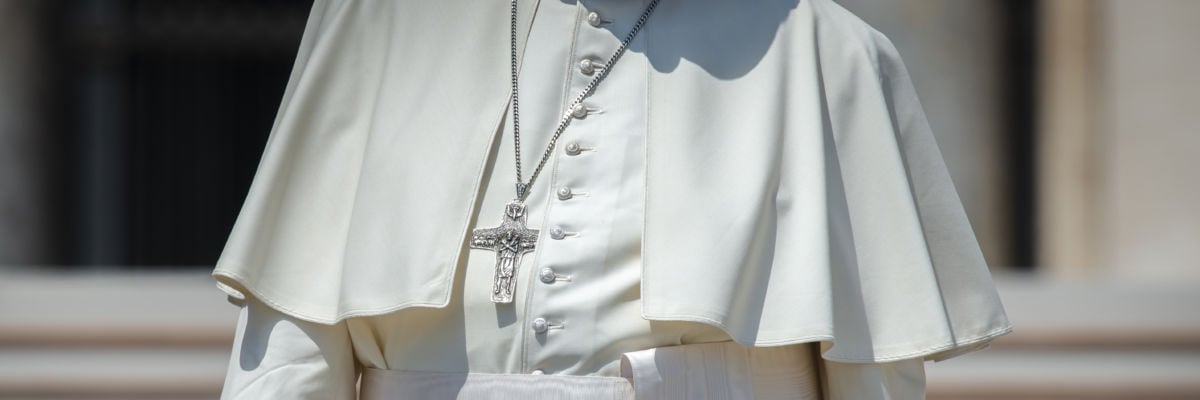
When the image at right showed up yesterday in my Facebook newsfeed, I imagined the groans and eye rolls of some of my Catholic friends. (And it wasn’t long before the responses—“Very Protestant” said one—started popping up.) According to the Catholic News Service story, members of EWTN’s Rome bureau brought a photo of Mother Angelica, the network’s founder, who died on Easter Sunday, to Pope Francis’s general audience yesterday.
The pope saw the photo in the crowd and blessed it when asked by an EWTN staff member for a blessing for Mother Angelica’s soul.
“She’s in heaven,” he said to the EWTN people, pointing to the sky.
The CNS article tried to contextualize the pope’s comment: “He isn’t the only one who is confident in the nun’s holiness. Several other prelates have voiced their admiration and appreciation for Mother’s contribution to the faith.” Yes, but none of those prelates—Benedict XVI, Archbishops Joseph Kurtz and Charles Chaput, Bishops Robert Baker and Robert Barron—said she was in heaven.
Gotta love the pope
You’ve got to love the pope because he acts like a regular guy. His response is one many people would have about someone like Mother Angelica. But sometimes you’ve also got to cringe because the pope acts like a regular guy.
Should a pope, because he’s the pope, resist the perfectly human impulse to declare that a recently deceased person’s soul is in heaven? Should he exercise special prudence to not act in ways or say things that may result in people conflating the imperfect human with the divinely appointed office?
Here’s the problem. It’s likely that some non-Catholics will see this news item and photo and assume the pope is announcing the sainthood of someone who has just died. I’m betting even a few Catholics might make the same mistake.
But the pope can’t just declare someone a saint. (Well, technically, he can—we’ll get to that in a minute—but it’s somewhat rare and certainly not done spontaneously at a general audience.) So, my eye-rolling friends would say, the pope is sowing scandal, in the technical sense.
Straight to heaven?
Many Protestant denominations teach that when faithful Christians die, God instantly purifies them, and they go straight to heaven. What this belief ignores is that salvation requires a response on the part of the person.
Before we can enter the perfection of heaven, we need to be cleansed not only of all sin but also endure the temporal punishment for sin, what St. Catherine of Genoa called sin’s “rust and stains.” By God’s grace through the sacrament of confession, we hope to be in a state of grace when we die; yet who could imagine himself perfect at that moment?
Some people do go straight to heaven. The Church holds that martyrs are cleansed for heaven by their ultimate self-sacrifice (see the Catechism of the Catholic Church 1472). But the rest of us, if we are headed that way, need to be purified. Hence the doctrine of purgatory.
The process of sainthood
Once someone’s cause for canonization opens, a detailed dossier (or positio) is assembled of the details of his life based on the testimonials of those who knew him well. This positio is submitted to the Vatican’s Congregation for the Causes of the Saints. From this officials determine his heroic virtue and investigate any miracles attributed to his intercession.
There are four stages of canonization: servant of God, venerable, blessed, and saint. One verified miracle qualifies the candidate for blessed status; a second one qualifies him as a saint.
As we noted earlier, the pope can bypass this process and declare someone a saint based on three criteria:
- A longstanding cultus (Latin, “veneration” or “worship”) among the faithful
- A general constant attestation by trustworthy historians to the virtues or martyrdom of the person
- Uninterrupted fame as a worker of miracles
This is called an equipollent (or equivalent) canonization. Pope Francis canonized Pope John XXIII in this way in 2014, waiving the requirement for a second miracle. But this is hardly tantamount to the pontiff spontaneously declaring someone a saint.
Prudence of the Church
So we see that in declaring sainthood, the Church—as it does in all matters of faith—moves slowly in order not to pass quick judgments that may cause scandal were they required to be reversed.
The Church allows wide latitude of belief; Catholics are not required to believe in, for example, Marian apparitions that have won ecclesial approval.
But when the Church declares a saint, Catholics may not dissent. Recognition of sainthood must be “definitively held” by the faithful as infallible under (at the very least) the universal magisterium of the Church. The faithful don’t have to have a devotion to the person, but they must believe that person is indeed in heaven because of earthly heroic virtue.
Has the pope’s “She’s in heaven” statement been misinterpreted by some? No doubt. It’s only more fuel for the smolder of debate about whether this pope’s approach of spontaneity and preeminent emphasis on love—which has attracted people never before attracted to the Catholic Faith but also caused confusion among the faithful—is a good thing or not.
I know what the eye-rollers would say. But it’s a debate that looks to be nowhere near resolution.


